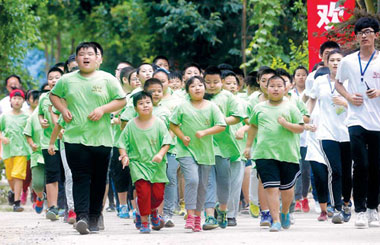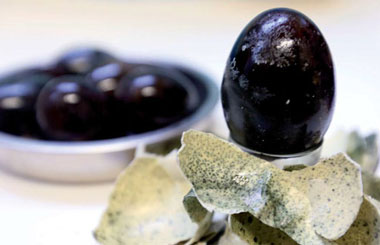Summer sun signals relief from allergies
Updated: 2016-05-24 08:22
By Yang Wanli(China Daily)
|
|||||||||
As temperatures start to climb, the incidence of allergic reactions begins to wane, as Yang Wanli reports.
The most difficult part of the year for Zhou Yan ended with the official start of summer on May 5. That signaled an end to her severe hay fever and conjunctivitis caused by poplar flowers and willow catkins, which floated in the air like snow during spring but gradually stopped as temperatures began to climb.
"Itchy, watery eyes, swollen eyelids and sneezing - every year, I get them all the time during spring. When summer comes, the symptoms disappear and I don't have to wear a facemask or take any more medication, which is great," said the 32-year-old Beijing resident.
Poplars and willows are abundant in the cities of North China. They were planted to act as windbreaks and also to prevent soil erosion, but their spores have resulted in a rise in the number of people with allergic reactions. Media reports show that hospitals in cities such as Beijing, Qingdao, Shandong province, and Changchun, the capital of Jilin province, have seen a rise of 30 to 50 percent in the number of patients with severe allergies during springtime.
The problem has been a hot topic recently on Baidu Tieba, a community-based group discussion, and Zhihu, an online question-and-answer forum where informed users provide accurate responses to users' queries.
In a recent discussion called "Westerners and Easterners: who has the higher incidence of allergy?" nearly 80 percent of Chinese respondents opted for Westerners. The result led a large number of people to suggest that many developed countries in Asia are less hygienic that their Western counterparts, which may produce "stronger" immunity in local people who have a natural resistance to allergens.
Triggers
However, experts and clinical trials have suggested that this isn't the case.
Chen Yifu, a general physician at the Beijing United Family Hospital, said allergies are caused when people come into contact with a trigger. In response, the body begins to produce an antibody called Immunoglobulin E, which attaches itself to blood cells known as mast cells and causes histamine and other chemicals to be released into the bloodstream, prompting an allergic reaction.
The symptoms depend on how people are exposed - through the air, the skin, food or even an insect sting. The symptoms of nasal or skin allergies commonly include itchy, watery eyes and skin rashes, while food allergies can cause stomach cramps, vomiting and diarrhea.
"Many people believe that Western people have a higher risk of developing allergies in China as a result of environmental pollution, but the fact is that pollution, for example the smog in Beijing, does not trigger new allergic cases among foreigners. Most expat patients with allergies come to our hospital because they have already had the problem in their home countries," he said.
"Some complain that their symptoms are worse on days when the air is heavily polluted, but that doesn't mean that their allergies have become more severe," he added, pointing out that previous clinical studies have shown that "inhalation" allergies - one of the most common reactions - occur equally in patients from the East and the West.
According to the United States Centers for Disease Control and Prevention, inhaled allergens affect about 40 million people, about 12 percent of the US population, and in Japan, clinical studies have indicated that one in every 10 people has an inhalation allergy, according to Chen: "Many Japanese who are allergic to cedar pollen will find that their symptoms disappear or are relieved if they visit China."
Rising incidence rate
China's health department has not yet conducted nationwide research into allergies, but based on data collected from hospitals around the country, it's estimated that the incidence rate has tripled in the past 30 years, according to a recent report by China Central Television.
The report also showed that more than 40 percent of Chinese people younger than 18 have some sort of allergy, and about 10 mill-ion people have allergic rhinitis, which affects the nose and nasal passages, making it the most prevalent allergy in China.
"Allergies have attracted more public attention in the past decade. In addition to improvements in the Chinese health system, which means more people with allergies attend hospitals for treatment, Chinese people hardly have severe allergic symptoms even to the same allergen, compared with Westerners," said Sha Li, a physician at the asthma clinic of the Capital Institute of Pediatrics in Beijing.
Yang Zhen, a doctor at the immunology department of the Shanghai Children's Medical Center, said an individual's genetic makeup not only determines which allergen will trigger a complaint, but also the severity of the symptoms.
She said people who have severe allergic reactions usually carry the genes from birth.
"Clinical experience indicates that such problems don't usually occur during childhood, but in adulthood. Moreover, it's widely believed that changing one's living environment is a major reason behind that," she said.
Despite general improvements in the quality of life and increased healthcare provision, China's rapid rate of urbanization is believed to have resulted in larger numbers of people being exposed to significant amounts of chemicals, both in the home and the workplace.
"Urban life provides people with more time to stay indoors. The use of air conditioners and carpets, and increased exposure to food additives and vehicle emissions raise the chances of a person aggravating an allergy," said Liu Guanghui, director of the anaphylaxis department - which treats potentially life-threatening allergic reactions - at the Tongji Hospital in Shanghai.
Liu said research shows that house dust mites are related to about 60 to 70 percent of allergic cases in China, including primarily asthma, eczema and perennial allergic rhinitis. Enzymes in their feces and exoskeletons are known to provoke allergic reactions, and urban lifestyles provide perfect living conditions for the mites, which are usually found in bedding, carpets, soft furnishings and clothing.
The problem seems certain to get worse, because urbanization is taking place at an unprecedented pace and is set to continue in the coming decades. In 1978, just 18 percent of the Chinese population lived in urban areas, but by 1995, the figure had risen to 30 percent and in 2013, it was 54 percent. The Chinese Academy of Social Sciences expects 60 percent of China's 1.3 billion people to be living in cities and towns by 2018.
Last year, the asthma clinic at the pediatrics institute in Beijing treated more than 25,000 child patients, according to Sha. She added that studies conducted by the hospital show that the incidence of asthma among children younger than 18 is higher in the greenbelt surrounding the capital than in the urban areas.
"Giving breast-fed babies a food supplement before the age of 6 months is one of the main reasons for the higher allergy rates in more-rural areas," she said. "Immunity takes time to build in infants. Giving them a food supplement too early will trigger their body's defense mechanism."
Lower sensitivity
Allergy treatments include medication and, increasingly, immunotherapy, under which patients are given gradually larger amounts of the substance, or allergen, to which they are allergic. The incremental increases prompt the immune system to become less sensitive to the allergen.
Despite the improvement in treatments, it is still impossible to cure the condition completely, according to Hu Jin, director of the pediatrics institute's dermatology department, who said intervention can only reduce the frequency of the ailment and control the symptoms.
"As they grow, many children will naturally see their allergic conditions becoming less severe. Some patients with skin allergies may find that the scale of their allergy may also diminish as they get older," she said, adding that her conclusion is based on more than a decade of clinical experience.
According to Hu, one of the most important stages the human immune system experiences is puberty (ages 10 to 15 for boys and 8 to 13 for girls). During this period, production of sebum, an oily substance that lubricates the hair and skin, rises under the influence of hormones.
"Patients with skin allergies such as eczema - a common skin complaint - will see their symptoms relieved during puberty, thanks to the increase in the amount of sebum being produced," Hu said. She pointed out that physical training can raise the level of immunity and help to control the severity of some allergic reactions, such as asthma.
The institute has run an annual summer camp for children with asthma for more than 20 years. Doctors provide about 20 children age 6 and older with training and guidance about treating their asthma at home. Parents are also welcome to attend and learn how to identify allergies and their causes.
To encourage the children to play more outdoor sports, the hospital also holds the Children's Asthma Olympics every year. "We want to invite more children to participate to help build up their confidence, so they will believe they can have the same life as every other child," Sha said.
Tang Yue contributed to the story.
Today's Top News
Alibaba expands in Belgium amid protectionism
Eiffel Tower to become rental apartment for first time
Wreckage of crashed EgyptAir plane found at sea
Still learning
EgyptAir denies finding wreckage of missing flight
China urges US to halt close surveillance
Debris found in sea in search for missing MS804
LinkedIn matches refugees with jobs
Hot Topics
Lunar probe , China growth forecasts, Emission rules get tougher, China seen through 'colored lens', International board,
Editor's Picks

|

|

|

|

|

|







